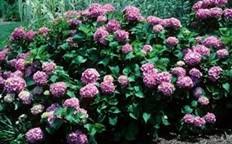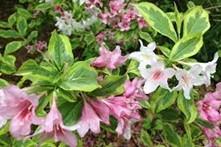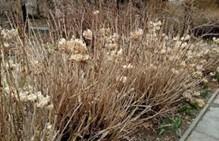Springtime Pruning Tips

Rhododendron
We all know that our woody landscape trees and shrubs benefit from regular pruning to maintain health and aesthetics. When to prune to maximize bloom can be the tricky bit. There are a few rules to remember to help you keep your wood plants in good health and looking great.
- Spring-flowering shrubs like forsythia, lilac and azalea bloom on ‘old wood’, that is they typically start to set buds for the next season’s blooms a few weeks after this season’s flowers have gone by. Prune them soon after they finish flowering to maximize blooms next season. You can prune them at other times, but pruning at the end of the season or over winter means you may be taking off buds for next year, effectively wasting the energy that plant has expended making them. Best to prune now and give the plant all season to grow and build energy for next Spring’s show.
- Summer-flowering woody shrubs like spirea, panicle-type and smooth hydrangea, and roses bloom on ‘new wood’ and should be pruned late winter/early spring while they are dormant. If you haven’t already given them the Spring cleanup and they’ve started to leaf out, you can prune away deadwood but best to leave a big prune until next winter. There are some Spring-flowering spirea, like Bridal Veil, that bloom on ‘old wood’ like lilacs, so like other Spring bloomers, prune them thoroughly once they’ve finished flowering.
- Maintenance pruning is lighter pruning done regularly/annually to keep woody shrubs looking great season to season. Rejuvenation pruning is less frequent but more dramatic and generally used with mature shrubs that are getting less productive. With multi-stem shrubs like lilac & Forsythia, older (1-2” thick) stems should be cut down to the ground to make way for younger, more floriferous shoots to mature. You can also cut really overgrown shrubs to 6-12” to the ground to get control again.
- Shearing is best left to formal hedges. While we might aesthetically admire the uniformity of rounded plant forms, over time it is not as healthy for the shrubs as allowing them to maintain their natural form and character.
For more details on spring pruning:
When and how do you prune an overgrown forsythia? | Extension
The Basics of Pruning Trees and Shrubs [fact sheet] | Extension
Science of Pruning Q&A | Extension – some great answers to specific pruning questions
Pruning, Topping & Staking Trees & Shrubs, plus Witch Hazel Appreciation [audio] | Extension
https://njaes.rutgers.edu/fs1221/ - includes a good list of plants and when to prune them
https://extension.psu.edu/pruning-flowering-shrubs
How to prune flowering shrubs for more blooms | Good Growing | Illinois Extension | UIUC


